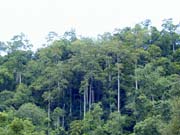 |
|
he Cloud-kissing Wang Hsie |
|

|
When stepping into the boundless tropical rain forests in Xishuangbanna, many people who come here for the first time will feel quite surprised at a kind of cloud-kissing tree before their eyes. They may let themselves ask: what is the highest tree in the rain forest? The answer is: among thousands of trees in the tropical rain forests of Xishuangbanna, the highest tree is the wang hsie tree. The highest wang hsie tree can grow as tall as more than 80 meters, and they are 20-30 meters higher than other kinds of trees in the rain forests. Though wang hsie is much shorter than a kind of eucalypt tree growing in Australia, which is as tall as 150 meters, and also shorter than the redwood growing in North America, which has a height of 142 meters; it looks quite outstanding in the tropical rain forests of Xishuangbanan. In all the rain forests vegetation of Asia and China, wang hsie is the tallest tree in the rain forests communities.
 |
|
The Tall and Upright Wang Hsie |
If wang hsie only grows very tall, it is nothing peculiar; and we cannot expect it to be listed as a Class A protection plant of the state level either. It is precious because it is a member of the camphol plant family, which is an advantageous specie in the tropical rain forests of Asia. In Southeast Asia, plants of this family are the representing trees of the rain forests and are important symbols of tropical rain forests. In the past, some foreign scholars asserted that "China has no plants of the camphol plant family" or "China has no tropical rain forests". However, the discovery of the wang hsie not only overthrows such assertions, it also proves that China has tropical rain forests in real sense.
 |
|
No. One Aerial Corridor in China |
Wang hsie trees are tall and upright; the trunks of the trees are round and straight, they have no forks, and their canopies look like huge umbrellas. Similar with other arbor trees of the eng family, wang hsie trees are famous on the world wood markets because of its superb wood quality and its unit wood yield. According to the records, a wang hsie tree as tall as 60 meters may produce as many as more than 10 cubic meters of trunk materials. The wood of wang hsie tree is heavy, the wood structure is even, the wood grains are straight and trunk itself is not easily tortured; therefore, wang hsie has very good properties for further processing, and is suitable for using in machinery processing and for large construction materials.
The wang hsie trees of China were first discovered in Mengla County of Yunan in 1974. At that time, the botanical workers carried out an investigation in Bubang according to the clues provided by Mengla Forestry Bureau, they found the wang hsie trees scattered in groups along the valleys of the dense forests. They grew upward and upward, but they occupied very small land areas; within one mou (1/15 hectare) of land, there were as many as more than 10 such trees. The place they found wang hsie trees had more than 100 wang hsie trees and they formed a small plant community. The botanical workers, based on the structures and shapes of its leaves, flowers and fruits, believed that it was a new specie of the eng family; and they also gave it a sonorous name - Wang Hsie, which means "one can only see its top when looking at the sky". Ever since then, wang hsie tree was recorded in the Chinese plant catalogue. In the recent years, tourism became quite hot in Xishuangbanna; the local Natural Protection Bureau tried to be unique and they used ropes, boards and steel pipes to connect the wang hsie trees with one another in the air. They named the scene "a corridor in the air". When one walks in the "corridor in the air", he can not only experience heartquakes, he can also have a bird view over the whole forest and sense the miracles of nature.
In October of 1996, the Chairman of the World Wild Creature Fund and Duke of Edinburgh, Prince Philip, paid a visit to Xishuangbanan, and he planted a wang hsie tree personally. Nowadays, the wang hsie tree he planted is luxuriant in branches and leaves, and the canopy of the tree is already like a huge umbrella!
 
|

